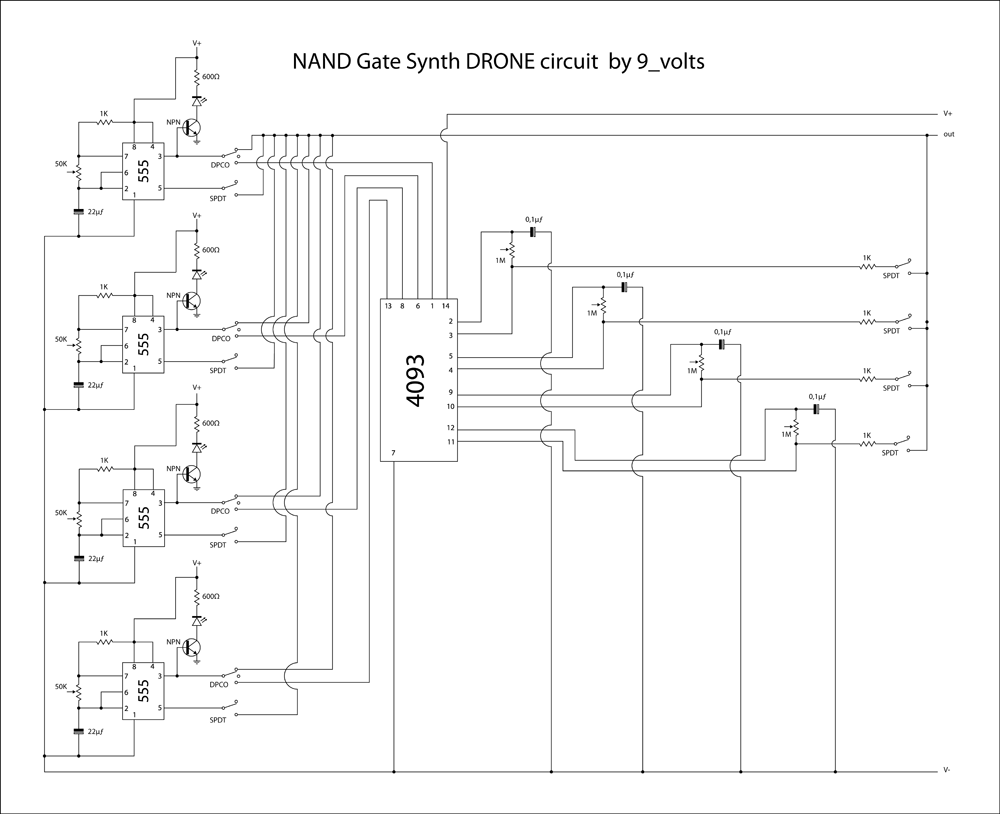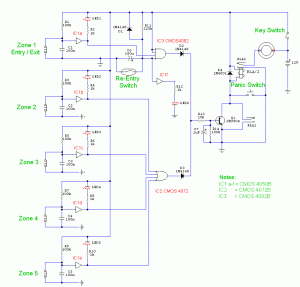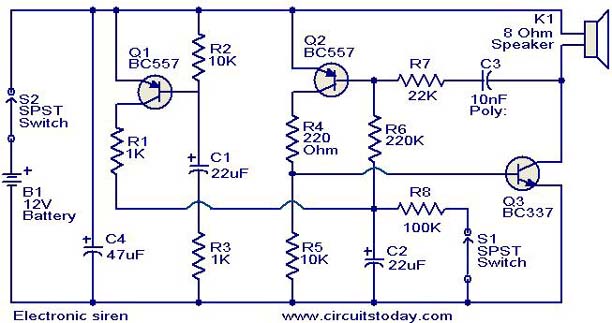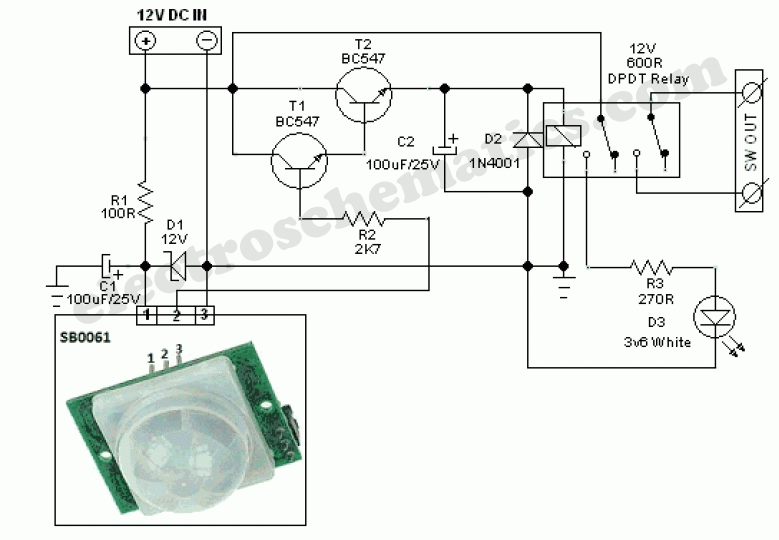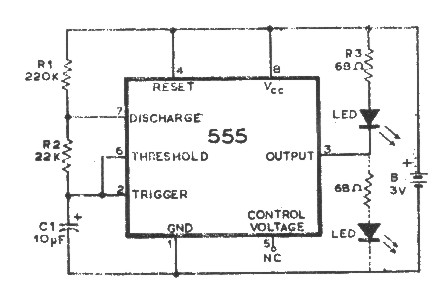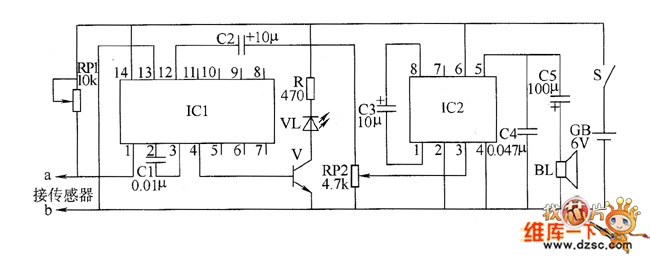
555 zinc-manganese batteries reduction charger circuit
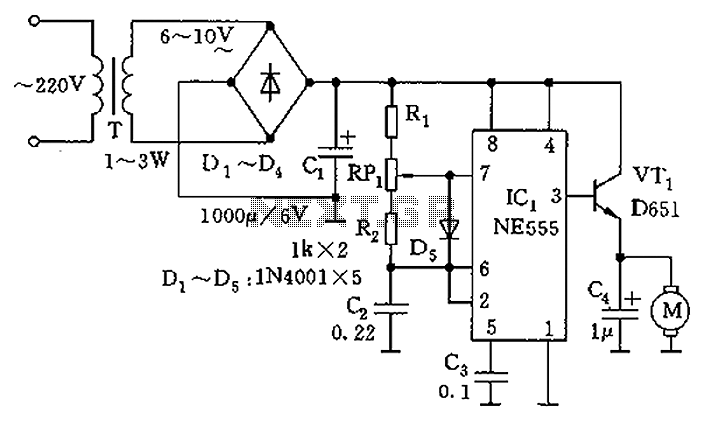
The circuit utilizes a 555 timer as the core component to create an astable multivibrator. The oscillation period T is given by the formula T = 0.693 (R1 + 2R2) C1, which corresponds to an oscillation frequency of approximately 100 Hz. The duty cycle is nearly 1:1. Consequently, the charger receives a charging pulse from the 555 output, with R6 serving as a current-limiting resistor. The D1 diode prevents the battery from discharging. The DW diode acts as a regulator; when the battery is not fully charged, DW is off, VT1 is also off, and the reset terminal (pin 4) of the 555 timer remains high, allowing the timer to oscillate. When the battery reaches full charge, DW conducts, saturating VT1, which then allows pin 4 to drop low, suspending the oscillation circuit and automatically shutting down the system. An LED flashes to indicate that charging is complete. The DW diode should be selected to have a rating that exceeds the 0.7V forward voltage drop of the VT1 transistor junction, ensuring that the battery voltage is slightly higher than its nominal value. By selecting different voltage sources (Vdd ranging from 5 to 15V) and various zener diodes, the circuit can accommodate different battery charging requirements. D4 serves as a reverse battery indicator, while R5 and C3 form a smoothing circuit. The circuit employs pulse charging, which is effective for reviving zinc-manganese batteries, but it is not suitable for lead-acid or rechargeable nickel-cadmium batteries.
The astable multivibrator configuration of the 555 timer generates a continuous square wave output that can be used to control the charging process. The resistors R1 and R2, along with the capacitor C1, determine the frequency and duty cycle of the oscillation, which is crucial for maintaining an effective charging rate. The choice of resistor values directly affects the time the output remains high or low, and thus the charging current delivered to the battery.
The current-limiting resistor R6 is essential for protecting the circuit and the battery from excessive current during the charging process. The diode D1 is strategically placed to prevent any backflow of current from the battery to the charging circuit, ensuring that the battery discharges only when intended.
The operation of the regulator diode DW is critical for managing the charging state of the battery. When the battery voltage is below the set threshold, the circuit remains active, allowing for continuous charging. Once the battery reaches its full charge, the conduction of DW and the saturation of VT1 effectively disable the charging circuit, preventing overcharging and potential damage to the battery.
The LED indicator provides a visual cue to the user, signaling when the battery is fully charged. This feature is particularly useful in applications where monitoring the charging status is essential.
The reverse battery indicator D4 enhances the safety of the circuit by alerting the user to incorrect battery installation. This feature is vital in preventing damage to the circuit and ensuring proper operation.
The smoothing circuit formed by R5 and C3 helps to stabilize the voltage supplied to the charging circuit, filtering out any noise that may affect performance. This stabilization is particularly important in battery charging applications, where consistent voltage levels are necessary for optimal charging efficiency.
Overall, this circuit design is well-suited for applications requiring efficient battery charging, particularly for zinc-manganese batteries, while providing essential safety features and user indicators. The flexibility in selecting voltage sources and zener diodes allows for adaptability to various battery specifications. Circuit 555 as the core to form a astable multivibrator. Oscillation period T 0.693 (R1 + 2R2) C1 Icon parameter corresponding to the oscillation frequency of about 100Hz or so . Duty cycle is close to 1: 1 Therefore, the charger is charging pulse 555 output by R6 directly after the charging current limiting. D1 diode prevents battery discharge. DW for the regulator diode, when the battery is not fully charged, DW off, VT1 tube off, then reset terminal 555 was 4 feet high and 555 in oscillating state; when the battery is fully charged, DW conduction, VT1 saturated conduction tube pass, the 555 was 4 feet by leaving the low oscillation circuit suspension, automatic shutdown when the battery is full, at the same time, LED flashes, it indicates charged.
DW should be selected so that the regulator Ratings plus 0.7V VT1 tube PN junction, the battery slightly higher than the nominal value. Thus, by selecting a different voltage source Vdd (5 ~ 15V) and different zener diode, to meet the different number of battery charging requirements.
D4 is reverse battery indicator. R5, C3 composition smoothing circuit. The charge reduction is the use of pulse charging, zinc-manganese batteries for the resurrection of the reduction is good, but not used lead-acid batteries or rechargeable nickel-cadmium batteries.
The astable multivibrator configuration of the 555 timer generates a continuous square wave output that can be used to control the charging process. The resistors R1 and R2, along with the capacitor C1, determine the frequency and duty cycle of the oscillation, which is crucial for maintaining an effective charging rate. The choice of resistor values directly affects the time the output remains high or low, and thus the charging current delivered to the battery.
The current-limiting resistor R6 is essential for protecting the circuit and the battery from excessive current during the charging process. The diode D1 is strategically placed to prevent any backflow of current from the battery to the charging circuit, ensuring that the battery discharges only when intended.
The operation of the regulator diode DW is critical for managing the charging state of the battery. When the battery voltage is below the set threshold, the circuit remains active, allowing for continuous charging. Once the battery reaches its full charge, the conduction of DW and the saturation of VT1 effectively disable the charging circuit, preventing overcharging and potential damage to the battery.
The LED indicator provides a visual cue to the user, signaling when the battery is fully charged. This feature is particularly useful in applications where monitoring the charging status is essential.
The reverse battery indicator D4 enhances the safety of the circuit by alerting the user to incorrect battery installation. This feature is vital in preventing damage to the circuit and ensuring proper operation.
The smoothing circuit formed by R5 and C3 helps to stabilize the voltage supplied to the charging circuit, filtering out any noise that may affect performance. This stabilization is particularly important in battery charging applications, where consistent voltage levels are necessary for optimal charging efficiency.
Overall, this circuit design is well-suited for applications requiring efficient battery charging, particularly for zinc-manganese batteries, while providing essential safety features and user indicators. The flexibility in selecting voltage sources and zener diodes allows for adaptability to various battery specifications. Circuit 555 as the core to form a astable multivibrator. Oscillation period T 0.693 (R1 + 2R2) C1 Icon parameter corresponding to the oscillation frequency of about 100Hz or so . Duty cycle is close to 1: 1 Therefore, the charger is charging pulse 555 output by R6 directly after the charging current limiting. D1 diode prevents battery discharge. DW for the regulator diode, when the battery is not fully charged, DW off, VT1 tube off, then reset terminal 555 was 4 feet high and 555 in oscillating state; when the battery is fully charged, DW conduction, VT1 saturated conduction tube pass, the 555 was 4 feet by leaving the low oscillation circuit suspension, automatic shutdown when the battery is full, at the same time, LED flashes, it indicates charged.
DW should be selected so that the regulator Ratings plus 0.7V VT1 tube PN junction, the battery slightly higher than the nominal value. Thus, by selecting a different voltage source Vdd (5 ~ 15V) and different zener diode, to meet the different number of battery charging requirements.
D4 is reverse battery indicator. R5, C3 composition smoothing circuit. The charge reduction is the use of pulse charging, zinc-manganese batteries for the resurrection of the reduction is good, but not used lead-acid batteries or rechargeable nickel-cadmium batteries.
